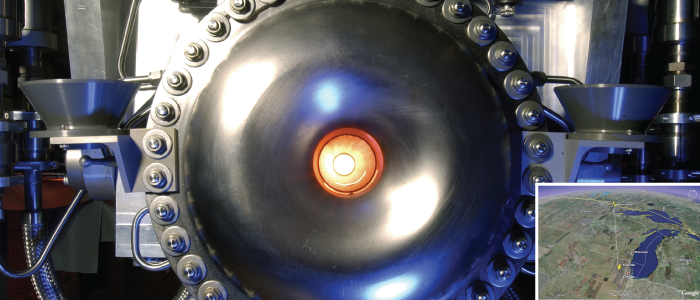Top: The NuMI horn that scientists use to focus and steer a beam of particles that eventually decay into neutrinos.
Bottom: Scientists will detect a small fraction of the neutrinos in a near-detector at Fermilab and in a larger far-detector in Minnesota. The particles will complete the 500-mile interstate trip in less than three milliseconds.
A researcher at the University of Cincinnati is leveraging the compute and storage resources of the Ohio Supercomputer Center to simulate the behavior of elusive cosmic particles. The research team is studying the behavior and nature of neutrinos and the particles’ role in the balance between matter and antimatter.
Alexandre Sousa, Ph.D., an assistant professor of Physics at UC, is one of 208 scientists and engineers from 38 institutions from seven countries participating in the Department of Energy’s Neutrinos at the Main Injector (NuMI) Off-Axis ve Appearance, or NOvA, experiment. Sousa is coordinating the development and validation of neutrino interaction simulations in the NOvA detectors and has been working with OSC staff to configure the Center to become what is now one of the experiment’s primary locations for developing and generating simulations.
Each second, more than a trillion neutrinos from the sun and other celestial objects pass through the average human body. While neutrinos are a billion times more abundant than the particles that make up stars, planets and people, they so rarely interact with other particles that they are very difficult to detect.
In the NOvA experiment, researchers are using particle accelerators to send intense beams of neutrinos straight through the earth between massive particle detectors at Fermilab in Batavia, Ill., and even larger ones 500 miles away at facilities in Ash River, Minn. For six years, the detectors will capture and record the interactions of the neutrinos, creating massive amounts of data that researchers will use to study neutrino properties, especially the transition of one type of neutrino into another. Even with these large detectors, researchers will be challenged to detect actual neutrinos and will turn to simulations built upon sparse actual results to estimate outcomes for larger numbers of neutrinos. These simulations are equally fundamental in comparing the observed data with our own theoretical knowledge to measure neutrino properties and perhaps uncover unexpected surprises.
“The generation of NOvA simulated data involves several steps and multiple software packages,” explained Sousa. “First, we will simulate the neutrino beam as it travels along its path and through the detectors. Second, we will simulate the neutrino interactions for each parent neutrino and its daughter particles. And, third, we will convert the detector energy depositions into digital signals analogous to the ones that will be produced during real data taking.”
Project Lead: Alexandre Sousa, Ph.D., University of Cincinnati
Research Title: A massively parallel computing approach to the generation of NOvA simulations
Funding Source: Department of Energy
Website: http://www.physics.uc.edu/~asousa/research.html

